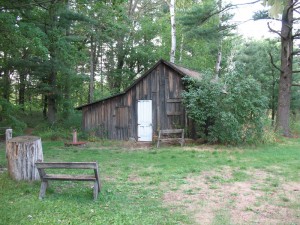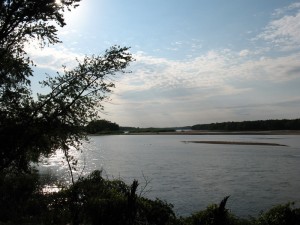This summer my family and I took our annual vacation to the Upper Peninsula of Michigan, where we camp out at the Bryson family cabin — a fairly humble one-room cottage in Hiawatha National Forest on the shores of little Crooked Lake (a lovely place to canoe and observe wildlife, among other woodsy pursuits). There’s no bathroom or hot water: just a hand pump in the cabin and an outhouse twenty yards out into the woods. The nearest little town of any note is about 12 miles up the road. Still, with a roof over our heads and electricity in the cabin, staying there feels rather more deluxe than, say, camping out in a tent.
After a week or so in the UP, we drove back roads through Wisconsin to Baraboo, where we spent a few days exploring the countryside and doing fun stuff with the kids. The Baraboo area is home to many delightful natural areas and sites of interest, including the much visited Devil’s Lake State Park; the beautiful though overly commercialized Wisconsin Dells; and the International Crane Foundation, a remarkable wildlife conservation facility. After our visit to the Crane Foundation north of Baraboo, we drove one of Wisconsin’s beautiful “rustic roads” that parallels a levee along the south bank of the Wisconsin River, and pulled off the road once we came to an unmarked turnoff in the middle of the woods.
Here I took a few minutes to hike a sandy road into a clearing not quite visible from the road. This is the site of “The Shack” — Aldo Leopold’s weekend retreat on the farm he purchased in the early 1930s as a family getaway and place where he could put into practice the conservation principles and restoration techniques he and others were developing in the early to mid-20th century.
Once a chicken coop that Leopold converted into a family cabin, the shack is a tiny structure by today’s standards. I realized as a walked around it, dwelling in its quiet presence, that it was significantly smaller than the 20×24-foot cabin we use in the UP — by comparison, our summer home is a roomy palace. Yet this humble shack looms large in American conservation and literary history, given its inspiration for Leopold’s classic 1949 work of environmental literature, A Sand County Almanac, and Sketches Here and There. Though I spent a mere twenty minutes or so at the site — listening to the wind filtering through the tree canopy, and wondering about the current of the Wisconsin River, flowing just to the north of the Leopold farmstead — it was impossible not to feel the power of this particular place. I left reluctantly.
 As we drove east on Levee Road, we pulled off again to scale the grassy levee, which was topped by a profusion of wildflowers — and enjoyed a commanding view of the Wisconsin River, here a wide and fast-flowing stream with many sandbars and heavily-wooded shorelines. Further on up the road, my wife spotted a family of wild turkeys, which scuttled up over the levee at the noise of our passing. We stopped to take a look at them, and watched mesmerized as the male set ran off first in one direction, toward the river, while the female led her young away at a different angle, toward a copse of trees. An exciting and special moment, one I was glad to have on the heels of finally seeing Leopold’s cabin after many years of simply reading about it.
As we drove east on Levee Road, we pulled off again to scale the grassy levee, which was topped by a profusion of wildflowers — and enjoyed a commanding view of the Wisconsin River, here a wide and fast-flowing stream with many sandbars and heavily-wooded shorelines. Further on up the road, my wife spotted a family of wild turkeys, which scuttled up over the levee at the noise of our passing. We stopped to take a look at them, and watched mesmerized as the male set ran off first in one direction, toward the river, while the female led her young away at a different angle, toward a copse of trees. An exciting and special moment, one I was glad to have on the heels of finally seeing Leopold’s cabin after many years of simply reading about it.